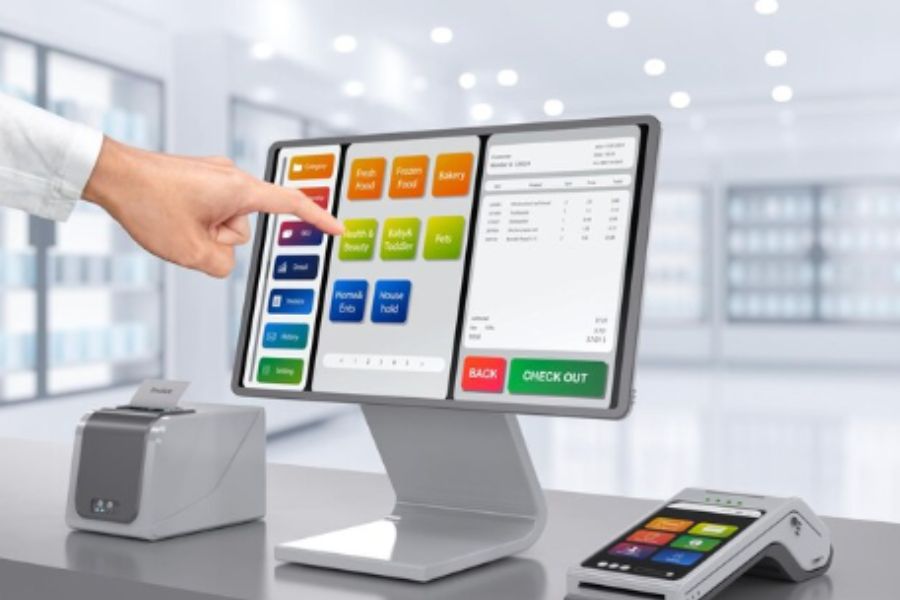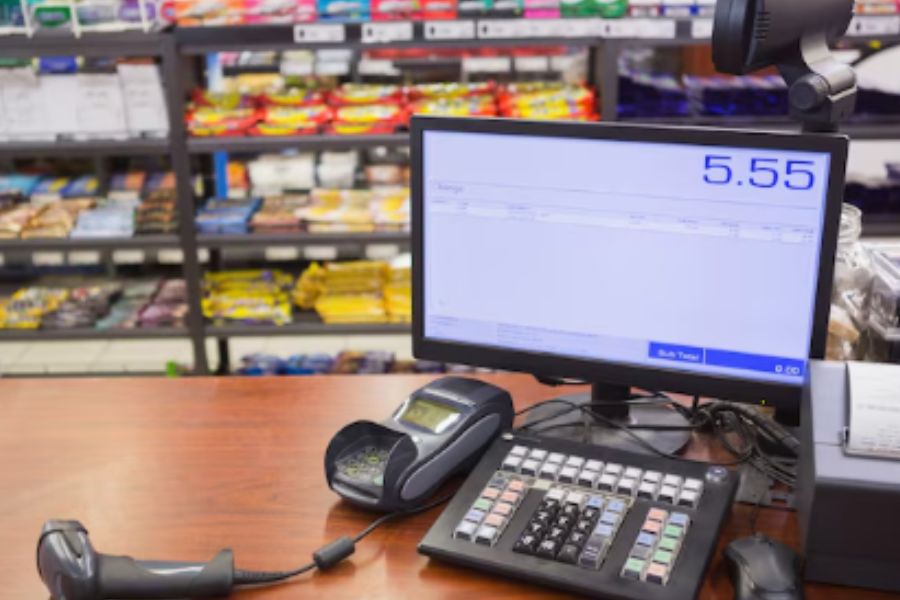In today’s competitive retail landscape, mastering retail point of sale software is essential for businesses aiming to thrive. This software streamlines transactions, enhances inventory management, and improves overall efficiency. In this article, we’ll delve into the three crucial steps to master retail point of sale software effectively. By understanding its functionality, selecting the right software, and implementing it strategically, businesses can unlock new levels of success in the retail industry.
Definition of retail point of sale software
Retail point of sale (POS) software is a specialized technology solution designed to streamline and facilitate various aspects of retail operations, particularly the transactional processes involved in selling goods or services to customers. At its core, retail POS software serves as the central hub through which businesses manage sales, inventory, customer data, and financial transactions.
At its essence, retail POS software serves as the digital equivalent of a traditional cash register, but with significantly enhanced capabilities and functionalities. It allows retailers to process sales transactions quickly and efficiently, whether in-store, online, or through mobile devices. By automating transaction processing, POS software minimizes errors, reduces checkout times, and enhances overall customer satisfaction.
Moreover, retail POS software provides comprehensive features beyond basic transaction processing. It enables businesses to manage inventory levels in real time, track product movement, and automate restocking processes. Additionally, POS software generates detailed sales reports and analytics, offering valuable insights into sales trends, customer preferences, and inventory performance.
Without retail POS software, businesses face numerous challenges and limitations that can hinder operational efficiency and competitiveness. Firstly, manual transaction processing without POS software can be time-consuming and error-prone, leading to inaccuracies in inventory management and financial records. This can result in stockouts, overstock situations, and discrepancies in sales data, ultimately impacting revenue and customer satisfaction.
Furthermore, without POS software, businesses cannot analyze sales data comprehensively, hindering their ability to make informed decisions and adapt to changing market conditions. Manual inventory management processes could be more efficient and prone to errors, leading to stock discrepancies, lost sales opportunities, and higher operational costs.
Importance of mastering retail POS software for businesses
Mastering retail point of sale (POS) software is of paramount importance for businesses operating in today’s dynamic and competitive retail landscape. This technology serves as the backbone of retail operations, enabling businesses to streamline transactions, manage inventory effectively, enhance customer experiences, and drive growth. The importance of mastering retail POS software for businesses can be understood through several key aspects:
- Enhanced operational efficiency: retail POS software automates and simplifies various operational tasks, such as processing sales transactions, managing inventory, and tracking customer data. By eliminating manual processes and reducing human errors, businesses can operate more efficiently, leading to improved productivity and cost savings. With streamlined operations, employees can focus on providing better customer service and driving sales, ultimately contributing to overall business success.
- Improved customer experience: in today’s retail landscape, providing exceptional customer experiences is crucial for attracting and retaining customers. POS plays a vital role in enhancing the customer experience by enabling fast and convenient checkout processes, personalized interactions, and seamless omnichannel experiences. With POS software, businesses can offer flexible payment options, access customer purchase history, and provide tailored promotions, thereby fostering stronger customer relationships and loyalty.
- Accurate inventory management: effective inventory management is essential for ensuring adequate stock levels, minimizing stockouts, and optimizing supply chain efficiency. Retail POS software provides real-time visibility into inventory levels, allowing businesses to track product movement, monitor stock levels, and automate reorder processes. By accurately managing inventory, businesses can reduce carrying costs, prevent overstock situations, and improve overall inventory turnover rates, leading to increased profitability.
- Data-driven decision-making: a POS system generates comprehensive sales reports, analytics, and insights that help businesses make informed decisions and identify growth opportunities. By analyzing sales trends, customer behavior, and product performance, businesses can identify areas for improvement, optimize pricing strategies, and develop targeted marketing campaigns. With access to actionable data, businesses can stay agile, adapt to market changes, and capitalize on emerging trends, thereby gaining a competitive edge in the retail landscape.
- Compliance and security: retail POS helps businesses comply with industry regulations and standards, such as PCI DSS (payment card industry data security standard), by ensuring secure payment processing and protecting sensitive customer data. With built-in security features such as encryption and tokenization, POS software helps mitigate the risk of data breaches and fraud, safeguarding both customer information and business reputation.
Three steps to Conquer Retail Point of sale software
Step 1: Understanding the basics of retail point of sale
Before delving into the intricacies of point of sale (POS) software, it’s essential to grasp the fundamental aspects of its functionality and components. Understanding these basics lays the foundation for effectively utilizing POS software to streamline retail operations and drive business success.
- Explanation of retail POS software functionality: Retail POS software serves as a comprehensive solution for managing various aspects of retail operations, primarily focusing on facilitating transaction processing and enhancing customer experiences. At its core, retail POS software acts as the central hub through which businesses conduct sales transactions, manage inventory, generate sales reports, maintain customer relationships, and oversee employee management.
- Key features and components of retail POS:
Transaction processing: Transaction processing is the core functionality of retail POS software, enabling businesses to conduct sales transactions efficiently and securely. This feature facilitates various payment methods, including cash, credit/debit cards, mobile payments, and digital wallets, ensuring convenience for customers. Transaction processing also involves real-time updating of inventory levels, deduction of sold items from stock, and generation of digital or printed receipts for customers.
Inventory management: Inventory management is a crucial component of retail POS software, allowing businesses to track and manage their inventory effectively. This feature enables businesses to monitor stock levels in real time, receive alerts for low stock or stockouts, and automate reorder processes to maintain optimal inventory levels. Inventory management functionality also includes barcode scanning, SKU management, categorization of products, and tracking of product movement within the store.
Sales reporting: Sales reporting capabilities of retail POS software provide businesses with valuable insights into their sales performance and trends. This feature generates comprehensive reports on sales metrics such as total revenue, sales by product category, top-selling items, and sales trends over time. Sales reporting helps businesses identify growth opportunities, optimize pricing strategies, and make data-driven decisions to enhance profitability.
Customer relationship management (CRM): CRM functionality within retail POS software allows businesses to maintain and nurture customer relationships effectively. This feature stores customer information, purchase history, preferences, and contact details, enabling businesses to personalize interactions and provide targeted marketing campaigns. CRM functionality also includes loyalty program management, customer segmentation, and communication tools for engaging with customers.
Employee management: Employee management features of retail POS software facilitate efficient workforce management and scheduling. This functionality includes employee clock-in/out, shift scheduling, performance tracking, and payroll management. Employee management tools help businesses optimize staffing levels, track employee productivity, and ensure compliance with labor regulations.
Understanding these key features and components of retail POS software lays the groundwork for businesses to harness the full potential of this technology in optimizing retail operations and delivering exceptional customer experiences. In the subsequent steps, we will delve deeper into selecting the right POS software for your business and implementing it effectively to maximize its benefits.
Step 2: Choosing the right POS for your business
Selecting the appropriate retail point of sale (POS) software is a critical decision that can significantly impact your business’s efficiency, productivity, and ultimately, success. To ensure you make the right choice, consider the following key factors:
- Business size and scale: the size and scale of your business play a crucial role in determining the type of POS software that best suits your needs. For small businesses with limited resources and simpler operations, a basic POS system with essential features may suffice. Conversely, larger enterprises with complex operations and multiple locations may require a more robust and scalable POS solution capable of handling higher transaction volumes and extensive inventory management.
- Industry-specific needs: different industries have unique requirements and challenges that need to be addressed by POS software. For example, retailers in the food and beverage industry may require features such as table management and kitchen display systems, while those in the fashion industry may prioritize inventory management tools and integration with e-commerce platforms. It’s essential to choose POS software that aligns with your industry-specific needs to maximize its effectiveness and relevance to your business.
- Integration capabilities with existing systems: compatibility and integration capabilities with your existing systems, such as accounting software, inventory management tools, and e-commerce platforms, are crucial considerations when selecting POS software. Seamless integration allows for smooth data flow between different systems, streamlining operations, reducing manual data entry, and minimizing errors. Look for POS software that offers robust integration options and supports popular third-party integrations relevant to your business.
- Ease of use and user interface: the ease of use and intuitiveness of the POS software’s user interface are essential factors to consider, especially for businesses with diverse staff members and varying levels of technical expertise. A user-friendly interface with intuitive navigation and clear instructions can reduce training time and minimize errors during operation. Additionally, customizable dashboards and workflows can enhance user experience and productivity, allowing staff to perform tasks efficiently and effectively.
- Customer support and training options: comprehensive customer support and training options are vital for ensuring a smooth implementation and ongoing use of POS software. Look for vendors that offer responsive customer support services, including live chat, phone support, and email assistance, to address any technical issues or inquiries promptly. Additionally, consider whether the vendor provides comprehensive training resources, such as online tutorials, user manuals, and onsite training sessions, to help your staff get acquainted with the software and maximize its capabilities.
By carefully considering these factors when selecting retail POS software, you can make an informed decision that aligns with your business needs, enhances operational efficiency, and drives growth in today’s competitive retail environment.
Step 3: Implementing and optimizing retail point of sale software for maximum efficiency
After selecting the right retail point of sale (POS) software for your business, the next critical step is to implement and optimize it effectively to realize its full potential. This step involves careful planning, seamless integration, thorough training, and ongoing monitoring to ensure maximum efficiency and effectiveness.
Planning and preparation for implementation: Successful implementation begins with meticulous planning and preparation to ensure a smooth transition and minimize disruptions to your business operations. Key aspects of planning and preparation include:
- Data migration and setup: one of the first tasks in implementing retail POS software is migrating existing data from legacy systems and setting up the new software to meet your business’s specific requirements. This process involves transferring customer data, product information, pricing details, and transaction history accurately to ensure continuity in operations.
- Employee training and onboarding: comprehensive training and onboarding are essential to ensure that your staff can effectively use the new POS software. Training sessions should cover all aspects of the software, including transaction processing, inventory management, reporting tools, and customer relationship management features. By investing in proper training, you empower your employees to leverage the full capabilities of the software and enhance their productivity.
Integration with other business systems and tools: Seamless integration with other business systems and tools is crucial to ensure smooth operations and data flow across your organization. Integration allows your POS software to communicate effectively with accounting systems, inventory management software, e-commerce platforms, and other critical business applications. This integration streamlines processes, eliminates manual data entry, and provides real-time insights into your business performance.
Monitoring and optimization strategies: Once your retail POS software is up and running, continuous monitoring and optimization are essential to maintain peak performance and identify areas for improvement. Key strategies for monitoring and optimization include:
- Performance tracking and analytics: utilize the built-in analytics tools of your POS software to track key performance indicators (KPIs) such as sales trends, inventory turnover, and customer behavior. By analyzing these metrics, you can identify growth opportunities, optimize pricing strategies, and improve operational efficiency.
- Regular updates and maintenance: stay up-to-date with software updates and perform regular maintenance to ensure that your POS software operates smoothly and securely. Regular updates often include bug fixes, security patches, and new features that enhance functionality and address emerging business needs. Additionally, routine maintenance tasks such as data backups and system audits help prevent downtime and minimize disruptions to your business operations.
By following these implementation and optimization strategies, businesses can maximize the efficiency and effectiveness of their retail point-of-sale software, streamline operations, and drive growth in today’s competitive retail environment.
FAQs (Frequently asked questions) about retail point of sale software
What is retail point-of-sale software, and how does it benefit businesses?
Retail point-of-sale (POS) software is a specialized technology solution designed to facilitate transaction processing, inventory management, sales reporting, customer relationship management (CRM), and employee management within retail establishments. It benefits businesses by streamlining operational processes, improving efficiency, enhancing customer experiences, and providing valuable insights for informed decision-making.
How do I choose the right POS system for my retail business?
Choosing the right retail POS software involves considering several factors tailored to your business’s unique needs. Factors to consider include business size and scale, industry-specific requirements, integration capabilities with existing systems, ease of use and user interface, and customer support and training options. Evaluating these factors will help you select a solution that aligns with your business objectives and operational requirements.
What are the essential features of retail point-of-sale software?
Essential features of retail POS software include transaction processing capabilities for various payment methods, inventory management functionality for tracking stock levels and managing product movement, sales reporting tools for generating comprehensive sales reports and analytics, CRM functionality for managing customer information and relationships, and employee management features for scheduling, performance tracking, and payroll management.
How does retail POS help with inventory management?
Retail POS software helps with inventory management by providing real-time visibility into inventory levels, facilitating accurate stock tracking, automating reorder processes, and generating alerts for restocking. Additionally, POS software enables businesses to track product movement, monitor stock turnover rates, and optimize inventory levels to prevent stockouts and minimize carrying costs.
Can retail point-of-sale software integrate with other business systems?
Yes, a retail POS can integrate with other business systems, such as accounting software, inventory management systems, e-commerce platforms, and customer relationship management (CRM POS) software. Integration allows for seamless data flow and communication between different systems, streamlining operations and improving efficiency across the organization.
How can I ensure a smooth implementation of retail point-of-sale software in my business?
To ensure a smooth implementation of the POS, businesses should follow best practices such as thorough planning and preparation, data migration and setup, comprehensive employee training and onboarding, integration with other business systems, and ongoing monitoring and optimization. Additionally, businesses should leverage vendor support and resources to address any challenges and ensure the successful adoption of POS software.
Conclusion
Mastering retail point of sale software is paramount for success in the retail industry. By following the three steps outlined in this article, businesses can optimize their operations, enhance customer experiences, and drive growth. If you want to know more about this information, feel free to contact us. Please feel free to contact us if you have any further questions.



